A very crucial component of tennis is knowing what the tennis grips are and what they are used for. A tennis grip is simply how you hold the racquet, with different types of tennis grips being used for different sorts of shots. The three primary styles of tennis grips are the Continental, the Eastern, and the Western, with a tiny variation of the Western grip called the Semi-Western grip. So, in this article, we will be going through the most popular tennis grips as well as how to recognize what kind of grip you are using at any time.
Guide : Understanding the Tennis Grips
At first sight of a tennis racquet’s handle, you might note that it has an octagonal shape. This is normal for all tennis racquets as it gives both comfort as well as enough friction to grasp it, so get used to it! Being that it has an octagonal form, the sides are referred to as bevels, which can assist you determine the type of grip you are utilizing depending on which bevels your fingers are put on. The type of grip will depend on which bevel the index knuckle and heel pad lie on.
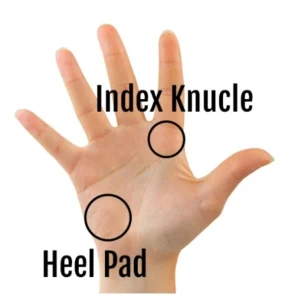
The bevels are numbered 1 through 8 going clockwise for right-handed players while they run counterclockwise for left-handed players. Bevel #1 will be the bevel facing up if you were to hold the blade of the racquet perpendicular to the ground. Keep this in mind as we go onto the different varieties of tennis grips.
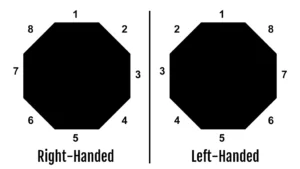
Types of Tennis Grips
Refer to our dictionary of tennis jargon if you encounter any words you don’t understand
Continental Grip
The Continental grip (sometimes called the Chopper grip or Hammer grip) is a specific grip intended primarily for serves, volleys, overheads, slices, and some defensive shots.
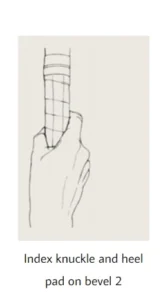
In order to use a Continental grip, your index knuckle and heel pad will rest on bevel #2. You will know if you have it properly if your thumb and fingers form a V over the top of the handle.
Advantages:
- Standard grip for serves and overheads, as it allows for you to naturally curl your wrist inward after performing these strokes. This results in more power and less stress on your arm.
- Preferred grip for volleys, as an open racquet face gives both underspin and control.
- Using the Continental grip for both forehand and backhand volleys provides for rapid shots while at net.
- Can be used for defense shots like as drop shots or wide balls.
Disadvantages:
- Hard to put topspin on the ball if using a Continental grip on forehand shots.
- Lack of constancy.
Eastern Forehand Grip
The Eastern forehand grip is generally employed for rapid, flat shots. Can also be changed rapidly from the Eastern forehand to the Continental grip for volleys. Shots with this style of grip will naturally be made at about waist level.
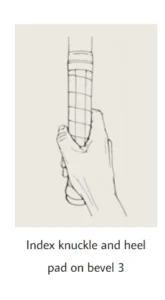
To get a good Eastern forehand grip, you will need both your index knuckle and heel pad to rest on bevel #3. You can alternatively place your hand flat against the strings and slide down to the grip to achieve an Eastern forehand.
Advantages:
- One of the easier grips for mastering forehand.
- Easy to transition from an Eastern forehand to a Continental.
- Great for players who enjoy attacking the net.
- Some topspin.
Disadvantages:
- Little control over high balls.
- Not enough control for long rallies.
Eastern Backhand Grip
The Eastern backhand grip gives both spin and control for a one-handed backhand, and can be even more adaptable if you employ a Western forehand grip, which uses the same grip.
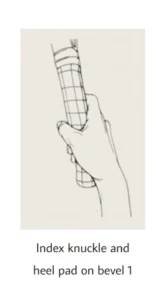
For an Eastern backhand grip, place your index knuckle and heel pad on bevel #1.
Advantages:
- Provides lots of control and ability to put spin on the ball Easy to adjust from an Eastern backhand to a Continental grip for players who prefer playing at net.
- Can also be utilized for a kick serve.
Disadvantages:
- Difficult to hit bullets at shoulder-height.
Semi-Western Grip
The Semi-Western grip has become a highly popular alternative for baseline players as it is able to produce both topspin and power, which can be devastating if learned correctly. That’s presumably why the Semi-Western grip has been popular for forehand over other tennis grips. The point of contact for balls will be between waist and shoulder-height.
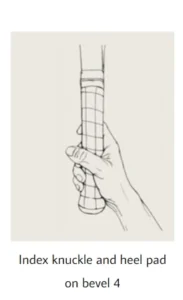
Place your index knuckle and heel pad on bevel #4 for a Semi-Western grip.
Advantages:
- Provides both topspin and power.
- More safety and control.
- Allows for contact points for shoots farther in front of you.
Disadvantages:
- Difficult to hit low balls.
- Harder to change from Semi-Western to the Continental grip for volleys.
Western Grip
The Western grip is not used as often as the other tennis grips since it is tougher to play with consistently, but offers the ability to apply severe topspin to your shots.
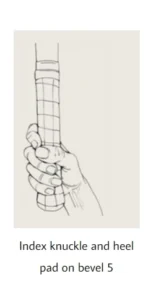
For a Western grip, place your index knuckle and heel pad on bevel 5.
Advantages:
- Creates more topspin than any other style of tennis grip.
- Balls generally bounce high and fast Contact points are further out in front of you.
Disadvantages:
- Very tough to return low balls.
- Harder to use on faster surfaces.
- Harder to convert to and from a Western grip.
Double-Handed Backhand Grip
The double-handed backhand grip is used extensively as it gives both stability and control. It is also easier to learn, which is why most novices start with backhands with two hands. The two-handed backhand relies significantly on shoulder rotation and accurate swing in order to produce power.
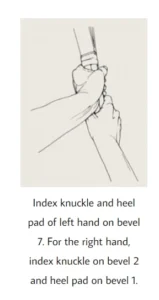
To achieve this grip, the index knuckle and heel pad of the left hand will rest on bevel 7, whereas for the right hand, the index knuckle will be
on bevel 2 while the heel pad is on bevel 1.
Advantages:
- Easier to learn than a one-handed backhand.
- Provides both stability and control.
- Great for low pictures.
- Can produce a lot of power and topspin.
Disadvantages:
- Takes extra time to setup.
- Limits a player’s reach, making wide shots harder.
Choosing the Right Grip for You
When selecting a tennis grip, consider your playing style, strengths, and weaknesses. Experiment with different grips during practice sessions to find the one that suits you best. Remember, the right grip can enhance your performance on the court.
Conclusion
Understanding tennis grips is essential for every tennis player, from beginners to professionals. By mastering different grips, you can improve your game and adapt to various playing situations. Practice regularly and experiment with different grips to find the ones that work best for you. With the right grip, you can unlock your full potential on the tennis court.
